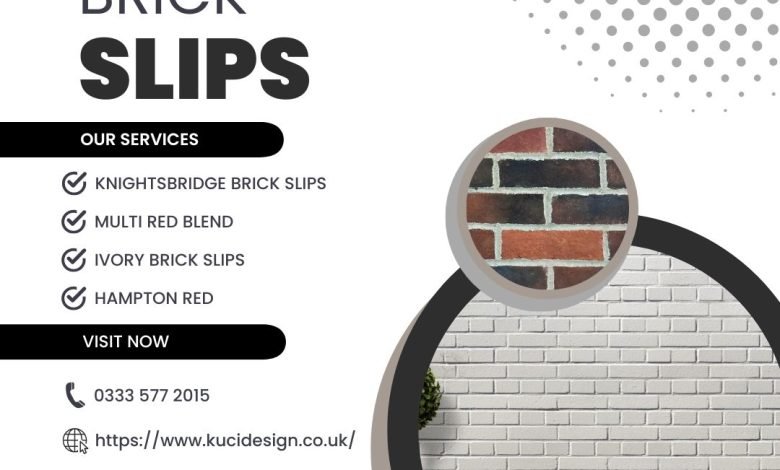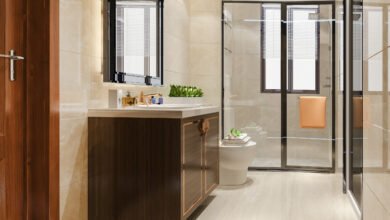“How to install brick slips: guide and its Benefits”

Introduction:
Brick slips are a popular choice for home renovation projects, as they can give your walls a stylish, modern look. If you are a DIY enthusiast, installing brick slips is a great way to improve the aesthetic appeal of your home. However, installing brick slips can be a challenging task if you do not have the right knowledge and tools. In this blog, we will provide a step-by-step guide on how to install brick slips in your home.
Step 1: Choose the right brick slip
The first step to installing brick slips is to choose the right type of brick slip for your project. Brick slips come in a range of styles and colors, so it’s important to choose a slip that complements your existing decor. Additionally, brick slips can be made from different materials, such as real brick, clay, or concrete. The material you choose will depend on your budget and the desired look you want to achieve.
Step 2: Prepare the wall
Before installing brick slips, you need to ensure that your wall is clean, dry, and free of any loose debris. If you are installing brick slips need to sand the surface to create a rough texture that the adhesive can bond to. It’s also important to check the wall for any structural damage or cracks that need to be repaired before starting the installation process.
Step 3: Measure and mark the wall
Once your wall is prepped and ready for installation, you need to measure and mark where the brick slips will be placed. You can use a tape measure and level to ensure that your marks are straight and even. It’s important to take your time with this step, as it will determine the final look of your wall.
Step 4: Mix the adhesive
Next, you need to mix the adhesive that will hold the brick slips in place. The type of adhesive you use will depend on the material of your wall and the brick slips. Most brick slip manufacturers provide recommended adhesives for their products. Be sure to follow the manufacturer’s instructions carefully when mixing the adhesive.
Step 5: Apply the adhesive
Using a notched trowel, apply the adhesive to the wall in small sections. Only apply enough adhesive for a few brick slips at a time to ensure that it doesn’t dry out before you have a chance to place the slips. The adhesive should be applied evenly and with enough thickness to ensure a strong bond.
Step 6: Place the brick slips
Once the adhesive is applied, it’s time to place the Install bricks slip onto the wall. Start at the bottom of the wall and work your way up, pressing each slip firmly into the adhesive. Make sure each brick slip is level and evenly spaced. Use spacers if necessary to maintain a consistent gap between the slips.
Step 7: Cut the brick slips
You may need to cut some of the brick slips to fit around corners or to fill in small gaps. You can use a tile cutter or a wet saw to cut the slips to size. Always wear protective eyewear and follow the manufacturer’s instructions when using these tools.
Step 8: Allow the adhesive to dry
Once all of the brick slips are in place, allow the adhesive to dry for at least 24 hours. This will ensure that the slips are securely bonded to the wall and will not come loose.
Step 9: Seal the brick slips
After the adhesive is dry, you can seal the brick slips with a waterproof sealer. This will protect the slips from moisture and ensure they stay looking new for years to come. Follow the manufacturer’s instructions when applying the sealer.
Common Mistakes to Avoid:
- While installing brick slips is a relatively simple process. There are a few common mistakes that DIY enthusiasts should avoid to ensure a successful installation:
- Failing to properly prepare the wall: If the wall is not properly cleaned, repaired, and prepped, the adhesive may not adhere properly to the surface. This can cause the brick slips to fall off or shift over time.
- Using too much or too little adhesive: Applying too much adhesive can cause it to ooze out from between the brick slips, creating an unsightly mess. Conversely, using too little adhesive can cause the slips to shift or come loose.
- Not measuring and marking the wall properly: Failing to measure and mark the wall accurately can result in uneven spacing and crooked lines, detracting from the finished product.
- Rushing the installation process: Installing brick slips requires patience and attention to detail. Rushing the process can result in mistakes, such as crooked lines or uneven spacing.
- Not allowing the adhesive to dry completely: If the adhesive is not allowed to dry completely, the brick slips may shift or come loose over time. Be sure to follow the manufacturer’s instructions and allow plenty of time for the adhesive to dry before sealing the brick slips.
The benefits of using brick slips in UK
Brick slips have become an increasingly popular choice for interior design in UK homes in recent years. These thin slices of real brick are easy to install and offer a range of benefits that make them an attractive option for homeowners. Here are some of the key benefits of using brick slips for interior design in UK homes:
Aesthetic Appeal:
Brick slips can add a touch of rustic charm and warmth to any room. They come in a variety of colours, textures and finishes, which means they can be used to create a range of different looks, from traditional to contemporary. They can be used to create feature walls or to add texture to smaller areas, such as alcoves or fireplaces.
Durability:
Brick slips are made from real brick, which means they are highly durable and resistant to wear and tear. They can withstand heavy foot traffic making them ideal for high-traffic areas such as hallways and living rooms.
Easy to Install:
Unlike traditional brickwork, brick slips are easy to install and require no specialist skills or tools. They can be fixed to almost any surface, including plasterboard, and can be easily cut to size using a tile cutter.
Low Maintenance:
Brick slips are easy to clean and maintain. They don’t require painting or sealing, and can be simply wiped clean with a damp cloth or vacuumed to remove dust.
Energy Efficiency:
Brick slips can help to improve the energy efficiency of a home by providing additional insulation. They help to regulate temperature by absorbing and releasing heat slowly, which can help to reduce energy bills and make a home more comfortable.
Versatility:
Brick slips are incredibly versatile and can be used in a wide range of interior design styles from industrial and rustic to modern and minimalist. They can be used to create a variety of effects, such as creating an accent wall, adding texture to a space, or adding interest to a fireplace.
Cost-effective:
Using brick slips is a cost-effective way to achieve the look of traditional brickwork without the need for expensive construction work. They are a more affordable option than traditional brickwork, as they require less materials and less labour to install.
Space-saving:
Brick slips take up less space than traditional brickwork. Making them ideal for smaller rooms or spaces where space is at a premium. They can be used to create the illusion of more space by adding depth and texture to a wall.
Fire-resistant:
Brick slips are highly fire-resistant, making them a safer option for homes. They do not release toxic fumes when exposed to fire. Which makes them a safer option for homes than other building materials.
Long-lasting:
Brick slips are a durable and long-lasting option for interior design. They can withstand wear and tear, and are resistant to chipping, cracking and fading. This means that they are a great investment that will last for years to come.
Overall, using brick slips for interior design in UK homes is a great choice for those looking to add a touch of character and warmth to their living spaces. They offer a range of benefits, from durability to energy efficiency, and are an affordable and easy-to-install option for any homeowner.
Tips : Also read Breathe Life Into Your Home With These Sofa Designs
Conclusion:
Installing brick slips can be a challenging task, but with the right knowledge and tools. It’s a DIY project that can be accomplished by most homeowners. By following this step-by-step guide you can install brick slips in your home and give your walls a stylish, modern look. Remember to take your time.
Follow the manufacturer’s instructions and prioritize safety when using tools and adhesives. With a little patience and effort, you can achieve a professional-looking finish that will add value to your home.
Benefits of using brick slips for interior design in UK homes are numerous. They offer a range of advantages, from aesthetic appeal to durability and energy efficiency.




